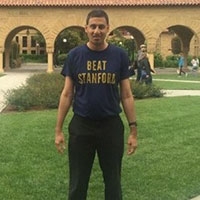During the past few years, UC Berkeley Extension has experienced significant growth in international student enrollment. In Fall 2017, Extension hosted 919 international students; in Fall 2018, we expect to host approximately 1,145 international students. This represents an approximate annual increase of 20 percent. The main source of growth has primarily been students from China, but Extension hosts students from all over the world.
While many Extension international students enroll in programs that are specifically designed for them, there has also been a rising number of international students who are enrolling into courses that have primarily comprised local San Francisco Bay Area students, especially in our business and science courses. As a result, you may notice more international students in your classes.
The length of study for international students can vary from a few weeks for custom programs to an entire year for standard programs. Many international students study with us for the following reasons:
- To prepare for applying to undergraduate or graduate programs in the United States
- To study abroad and transfer credit to their undergraduate or graduate degree program
- To advance or enhance their career and professional skills as post-baccalaureate students or working professionals
In order to be admitted into Extension international programs and receive an F-1 visa to study in the United States, international students must pass the Test of English as a Foreign Language (TOEFL) exam with a minimum score of 79 iBT (or an equivalent English proficiency exam and minimum score). Some programs have higher TOEFL score requirements. Students who attend or have attended a high school where the primary language of instruction is in English can apply to waive the English-proficiency exam requirement. Along with their application, students submit a Statement of Purpose in English that includes academic areas of interest. While studying with us, international students have access to an academic advisor and similar resources as degree students do.
We encourage you to create an inclusive and diverse environment in your classroom; however, we realize that many of you may be teaching international students for the first time. This may cause pedagogical challenges in your classroom, not only with language or cultural barriers but also with the varying depth of academic or professional experience among your students.
Teaching techniques that successfully support international students also support good pedagogy for all students. We spoke to four Extension instructors—Arun Sharma, Caitlin Kindervatter-Clark, Kateland Harte and Martin Medeiros—who have been teaching international students for several years to find out their best practices and advice and resources.
What do you view as the primary opportunities and challenges of teaching a combination of both American and international students in the classroom?
Kateland Harte: A diverse group of students is an enormous blessing for me as a teacher, and the class benefits from that range of cultural perspectives and helps the pedagogical process come to life. Culturally diverse groups have so much to teach and learn from one another, especially in class discussion and group work, both in terms of knowledge and in processes and ways of thinking.
Caitlin Kindervatter-Clark: Mixing American and international students is a great opportunity for cultural exchange on both sides. The advantage for Americans is that it can broaden their cultural understanding. For international students, the more mixed a classroom is, the more opportunities they have to connect and learn about American culture. The language difference and gaps can be challenging for some students. If a student has a foundational understanding of the English language, they usually can become successful with the proper support.
While it’s important to put things in writing in syllabi, you should also take the time to explain it up front.
Some international (and American!) students may not understand expectations regarding academic integrity, such as citing and documenting sources for academic papers. What tips do you have for setting these and other academic expectations for all students up front?
Martin Medeiros: I tell students, “When you are going into a new environment, you need to learn how things are done in that environment and you need to adapt to that culture.” Just like when others go to their country, they would expect them to adapt to their culture. I advise them to be aware of what the expectations are in that environment. You can’t just have expectations written in a syllabus; you also need to explain it. Syllabi are now nine pages long (syllabus bloat), and while it’s important to put things in writing in syllabi, you should also take the time to explain it up front. I use Canvas to post an introductory video to my class.
Kateland: I am explicit about these conventions. I take time in class to review, with Powerpoints and lecture notes, impressing upon them the importance of academic integrity and citing sources. I give them examples of proper citation for each new project. When I catch an instance of academic dishonesty, I take time to explain to the offending student that the consequences of plagiarism can be quite severe in U.S. colleges.
Caitlin: I require papers to be submitted electronically and run them through plagiarism-checking software. I show students the software so they can see how it works and how easy it is to find plagiarism. With language learners, it is usually pretty easy to spot plagiarism. When I encounter an incident with an international student regarding academic integrity, I first operate from the assumption that it may be a cultural misunderstanding and I take additional time to explain the expectations and give them an opportunity to redo the assignment.
Arun Sharma: I had an issue with one class of Chinese students where nearly the entire class were on their cell phones during the whole class. I told the program about it and suggested to communicate to all students that it’s not acceptable and it was taken care of.
In an Inside Higher Ed article called “Teaching International Students,” a topic that frequently comes up among instructors is how to most effectively assess international student writing. The University of Denver has published some Guidelines for Responding to the Writing of International Students: Principle and Pedagogy, which identifies three dimensions of evaluating each piece of a student’s writing: aptness of content and approach to the task, rhetorical fit and conformity to conventions of edited American English. Do you agree with the University of Denver’s approach for assessing international student writing or do you have your own approach?
Kateland: Generally, I would agree with this approach. When I assign a paper, it’s a two-week process from outline construction to drafting to creating an annotated bibliography to peer review. The rubrics for each draft assess grammar, usage, spelling/punctuation, originality, writing skills and rhetoric. I find that international students tend to be less familiar with U.S. writing standards than domestic students might be, so we take time to interrogate each stage of the writing process to better understand its function in the context of the whole work.
Caitlin: For writing assignments, my grading rubrics address the learning objectives for each assignment. For an argumentative essay assignment, I might create a rubric for:
- Evaluating the thesis statement
- Rhetoric of the body of paper
- Evidence and documentation of research
- Overall paper including writing/revision
- Presentation of the paper
These rubrics are the same for American students, but sometimes I might need to be more specific in defining the rubrics for international students, such as define “what is a thesis statement.”
Martin: I recommend to students that they have their writing proofread by someone else. I have noticed that some cultures tend to write reports in bullet-point form instead of a narrative format. When I explain that I want a narrative format, that usually gets my point across.
When there is a diversity of ability, I tend to pair more proficient students with less-proficient students when I assign group work to allow for peer-to-peer teaching.
On UC Berkeley’s Center for Teaching and Learning website, there is an article about Teaching a Mixed-Level Disparate Class. What do you do when your class is divided: When you see that a few students find the material easy, are bored and yearn to be challenged, while some still just aren't “getting it” despite your best efforts?
Martin: That’s a big problem in the classroom, and it’s amplified in quantitative classes. There is a risk of reducing the standards and not challenging people. A very common phrase in my economics class is “I’m not good with numbers.” Students are setting themselves up for failure when they say that and it is poison. When students come into the classroom with low expectations of themselves, I try to identify it quickly and encourage them to be open to the topic and suggest that maybe they need to work harder so they don’t get discouraged or don’t dismiss the topic altogether as being “not for them.” For advanced students, I encourage them to focus on a project that interests them and tell them that there will be at least one new thing or new way of doing something that they will learn in class.
Arun: In the Fall Program for Freshmen, students took similar courses in high school, but they all come from different high schools and enter the class at different levels. I keep the level of the class consistent and maybe adapt it slightly to the class needs. I explain and warn those students who are potentially behind that they may need to work harder and may need to ask for more one-on-one help. I tell them not to get discouraged too quickly as it rarely happens that any student coasts through the class. It requires hard work by most to succeed. Sometimes students would ask questions after class to delve deeper or ask about other topics not related to class. I find out what they are interested in and recommend other things to study.
Caitlin: I operate from the assumption that it’s better to challenge students, and I set the content level higher. But if some students are struggling with the readings, I will make more time to help break down the reading into outline format so that they understand the content needed. I hold office hours and sometimes set aside time in class for the students to work on their writing while I meet individually with students. If there is a student struggling with the basics, I consult with the College Foundations Program to refer them to outside resources.
Kateland: This is always a challenge—particularly this summer. When there is a diversity of ability, I tend to pair more proficient students with less-proficient students when I assign group work to allow for peer-to-peer teaching. I also make time for individual conferences with students where I comment to their ability, strengths and areas for improvement. My grading scale in such instances tends to measure how well each student is improving, and their final grade would reflect the growth they’ve demonstrated in the class.
For students who are not confident in their language skills, how do you encourage and facilitate classroom discussion and participation?
Martin: I first acknowledge and convey to students how impressed I am that they are taking a class that is not in their own language. I tell them how important it is to speak in public and explain that the classroom is a safe environment: “You’ll feel more comfortable if you give it a try here in class.” I give them basic public-speaking tips on eye contact, tone of voice, et cetera. Before their presentation, I ask them questions that they can easily answer to warm them up, put them at ease and get the momentum going. I also give help where help is asked.
Kateland: I find that international students with underdeveloped language skills sometimes feel more comfortable writing than speaking. They often are very adept at understanding what is being said, presented or written, but experience frustration when it comes time to speak or present. To help them work through this process, I make time for reflective journaling in class on the topics or texts in question. I find that giving students time to reflect upon a question in writing before speaking to it helps them feel more comfortable and better able to make that verbal connection.
Caitlin: I do a mixture of small-group discussions of three to four students and whole-class discussions and presentations. I make sure that there are plenty of opportunities to speak without having to be in front of the entire class. Quieter and less-confident students feel more comfortable and have more of an opportunity to speak in small-group discussions. Sometimes students pick the group, and sometimes I pick the group based upon different levels and styles. I will sit in on each group so that I can hear the students and help facilitate the discussion. I also facilitate peer reviews, where a student will review another student’s paper, which requires them to participate and talk. Classroom presentations are another way to make sure that students are able to talk in front of the whole group. While classroom presentations cause some anxiety for international students, I explain to them that it’s an important skill that you need to have in academia.
Do you have any tips on how best to organize group work or projects?
Kateland: I often teach teenagers and find it necessary to observe closely to make sure everyone has a role and is actively participating. This prevents the very common classroom dilemma in which one person is doing all of the work. My students will often share Google docs to work through ideas together outside of the classroom. It helps to see one another’s edits in real time and on the same document.
Martin: In my simulation class, I team up three to four students. I always make sure that the team is comprised of members that do not speak the same language. I also try to pair an even mixture of female and male students whenever possible. For students who speak the same language, there is a risk that they will speak to their teammates in their own language and isolate others who don’t speak that language. Sometimes an entire cohort of students may be from one country and this is unavoidable.
Caitlin: My Saudi students all major in science and technology (STEM), and I ask them to write and present a mock National Institutes of Health (NIH) research proposal, an organization that gives research grants to scientists each year. The proposals have to be in a specific format and I refer them to the NIH resources and give them a sample proposal. The projects and budgets are imaginary, and they pretend to propose a research project to NIH or some other research-funding organization as a contest. The class votes on the winning proposal. For this project, I grade each student separately. They are individually accountable, but adding the group element creates team motivation.
I come to each class with a new topic, often drawn from current events or recent public debates, and a set of questions to ask and answer together.
How do you adapt your teaching to be inclusive to all types of students? How long did it take?
Kateland: I learned to establish a developmental arc for myself and each new group I work with. I come to each class with a new topic, often drawn from current events or recent public debates, and a set of questions to ask and answer together. Often, these are topics and questions that I do not have a firm personal opinion about yet. The goal is to probe all aspects of the issue together with the group, teaching and learning from one another. Sometimes with international students, I may need to very quickly learn something about a region or culture so I can speak to that context. It is so refreshing and fascinating to gain new knowledge and perspectives from international students.
Martin: Sometimes a classroom is dominated by a group from one country and they may be over-represented. This presents its own challenge, and it’s important to not ignore the other students with different backgrounds. You need to develop a universal default teaching style that you can adapt accordingly, but at the same time you don’t want to adapt it too much toward the predominant group or you risk leaving some students out.
Arun: The very first class I taught had international students. Over time, I became aware of what worked. Math is math, and a language barrier isn’t nearly as big an issue as it likely is in other classes like writing courses. But they are raised with different standards. Most of the international students I teach aren’t reliant upon calculators nearly as much as American students. So I have to do something different with American students and train them not to use calculators.
For Extension instructors who have never taught international students before, where would you recommend that they start?
Caitlin: I always ask my students to watch the Ted Talk “Danger of a Single Story” by Chimamanda Ngozi Adichie, a Nigerian novelist who came to the U.S. as a college freshmen and has written several novels including Americanah. I highly recommend this to any instructor who works with international students because it challenges the primacy of one narrative that we have about culture and the humanities.
Martin: I suggest that instructors sit in on a class that includes international students for peer review. If the instructor has several students from one country, they can do research on the culture, but sometimes that is challenging if you have students from multiple countries.
Kateland: I put to the students genuine questions. For instance, the service-learning course was initially very challenging content to plan. They have service time and in-class time. I wanted to make sure that class time was meaningful and challenging. So we examine and reflect on the larger structure of society, and the factors that create a need for service work. I ask big questions about inequalities, ethics and the shape of society. For example, “why should we feed the hungry?” This introduces an ethical debate that really captures the students’ imaginations and challenges them.
Teaching with humor and enthusiasm keeps things lively and is appreciated by the students.
Is there any other advice you would give to instructors?
Arun: There will be some differences between U.S. and internationals students. You will have to approach things slightly differently, and you will learn in time what works well with each group. Rely on experience before changing things.
Kateland: In the College Foundations Program, I teach very bright and gifted students who know all kinds of things that I do not. As a consequence, I have had to give up the notion that I have all of the answers. I open the class as a collaborative inquiry, guiding students to use their knowledge and analytic skills to think critically together and to interrogate their own assumptions. It has made the class experience exciting and intellectually rich.
Caitlin: Stay up to date on world affairs and current events and try to understand the things that might impact your students. Be an informed international citizen. Don’t be afraid to allow your students to teach you: Ask questions about their background, listen to what they have to say and work it into an assignment. One writing exercise I give is an extended definition for an untranslatable word or phrase. I ask my students to write a short extended definition of a word or phrase in their native language that cannot be translated or easily explained in English. I once had a Japanese student write about a word/phrase that roughly translates to “finding shelter in order to wait for the rain to stop” and this word is used in many Japanese movies and love stories.
Martin: In addition to having content expertise, teaching with humor and enthusiasm keeps things lively and is appreciated by the students.
For a summary of the teaching strategies suggested in this article and links to additional teaching resources, please see Key Insights: Best Practices for Teaching International Students.
In addition, if you would like to observe an international class or are hitting a specific pedagogical challenge in your course, please reach out to UC Berkeley Extension’s Center for Instructional Excellence at teach-extension@berkeley.edu for further advising and support.
Read More About Our Featured Instructors
Arun Sharma Caitlin Kindervatter-Clark Kateland Harte Martin Medeiros




